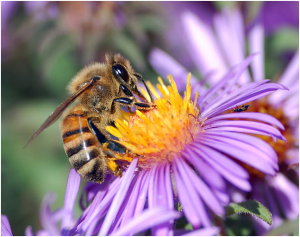Taking care of our bees’ nests
Over the last few years there has been a lot of speculation about the causes and effects of the large drop in bee populations around the world. CCD (Colony Collapse Disorder) is a very real and dangerous phenomenon that we are seeing in more and more countries. Arguably, it started in October 2006 and the effects of this could be catastrophic – not just for the honey industry, but for agriculture in general. It is estimated that close to one third of our food supply, worldwide, is linked to pollination. Bees are the main contributors to pollination, so this is a serious issue that needs to be addressed before it’s too late.
Source: http://en.wikipedia.org/wiki/File:European_honey_bee_extracts_nectar.jpg
There has been a sudden drop in bee populations in some countries in Europe and in North America. The causes at the moment are heavily debated as many people’s research and data is independent and in need of unifying. There is also a lot of money to be made in farming and in the chemicals used as pesticides, so it’s hard sometimes to wade through the hidden agendas to get to the raw facts. There are some aggregate factors that most experts agree are at least contributing to CCD and to the drop in bee populations in general in the non CCD-affected countries, such as the UK. Some of the factors killing bees are as follows:
- Chemical pesticides – specifically neonicitionoids, such as Imidacloprid or Thiamethoxam, are easily soluble in water and attack the nervous systems in most insects. Bees aren’t the targets of these pesticides; they are more like collateral damage when farmers are careless when spreading the neonicotinoids.
- Disease from viruses (IIV6), fungi (Nosema Ceranae) and other issues as a result of poor beekeeping practices and hygiene.
- The parasite, Varroa Destructor. This unpleasant little vampire mite is the scourge of apiculturists everywhere. The female mites lay eggs in the beehive and the little mites attach themselves to the larvae and worker bees. The Swiss government reported an approximate loss of 50% of its bee population after the 2011 winter. It blames this massive loss on the growing varroa problem. Humans compound the issue by moving bees around from place-to-place, from country-to-country; this helps the varroa mites spread to unconquered climes.
- Extreme weather plays a big part. Last year in the UK has taken its toll on the bee population, with its wet summer and autumn and its record-breakingly cold and long winter extending well into this year. A way to address this might be to concentrate more minds and efforts on climate change. This isn’t a problem that’s going to be fixed overnight.
- Situating bees next to monocultured crops (crops all of the same type of plant) is a dangerous practice as it limits bees’ diets, which can lower their immune system and make them more susceptible to the diseases mentioned above. Often beekeepers only let their bees feed on one type of plant in order to accent the flavour of the honey. They also move the bees around to let them feed on specific plants. This also helps spread disease and varroa mites. This practice needs to be controlled – perhaps in the same way that the transport of livestock is controlled.
There are other issues, but these are the main culprits. It would be impossible to solve them all at once, so perhaps the most attainable change is to prevent or limit the transportation of bees. Perhaps the disease problems would be somewhat resolved by this and we can start to get a handle on these crisis. If we don’t, it’ll not only mean ruination for a lot of the honey producers, but the potential loss of a variety of plant-life around the world.
References:
http://www.theglobeandmail.com/technology/science/no-honey-more-problems-a-catastrophic-year-for-bee-colonies/article13542705/




